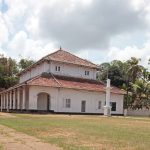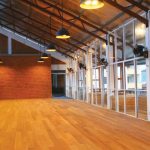-
Cliffhanger
July 2013
 Holiday homes allow an architect to explore new ideas and thoughts that can push architectural thinking to a level, which may not always be possible in a more domestic everyday situation. These buildings are able to suspend the functionality of everyday life and look at architecture purely for its aesthetic and spiritual qualities.
Holiday homes allow an architect to explore new ideas and thoughts that can push architectural thinking to a level, which may not always be possible in a more domestic everyday situation. These buildings are able to suspend the functionality of everyday life and look at architecture purely for its aesthetic and spiritual qualities.
By Archt. Channa Daswatte
The magnificent sweep of Weligama Bay has become the place for several such homes starting with the one built by Count de Mauney in the mid 20th Century followed by many others including well known architects, Tadao Ando, Anjalendran and Geoffrey Bawa. The attraction of the Bay is made quite clear when viewed from the deck of a house built on its eastern cliffs by the architect Shigeru Ban. And the house simply does just that – become a deck from which to observe and feel the bay at first hand.
The approach to the house is through a thickly planted driveway that ends in a perforated concrete wall with a suggestion of grass steps leading up and behind it. These steps lead into an entry terrace enclosed on three sides by the same triangular perforated concrete blocks and a wall of louver shutters on the fourth. A solitary Araliya (Plumeria rubra) tree will eventually fill this space that allows access to the house through one of the louver shutters at the top of a few steps.
In spite of the roof overhead and perhaps because of the nature of the material of that roof, the whole space somehow appears to be still very much a landscape element.
The gap in the louvered shutters leads onto a further series of terraces covered over by a vast floating roof, which appears to be a giant woven mat. The entry terrace from which a door leads into an enclosed cinema room is the lowest with the dining terrace and living terrace leading up to the magnificent view of the bay over a swimming pool suspended at the edge of the last terrace.
The Cliffhanger.
In spite of the roof overhead and perhaps because of the nature of the material of that roof, the whole space somehow appears to be still very much a landscape element.
A series of garden terraces covered over by a light suspended mat to give a semblance of shade and protection from the sun and perhaps the rain. Its efficacy over rain was suspect on a monsoon afternoon, but that only helped to heighten the feeling that this was a space to both confront and enjoy nature in all its manifestations, be it storm or calm. The wall of louver shutters controls and mitigates the wind or breezes, as the case may be, reasonably effectively but the point is that nature here is to be experienced first hand. In fine weather, with the louvers all open, the main living space of the house becomes simply a series of garden terraces from which to commune with the magnificent site.
The house actually consists of two quite separate buildings; a two storied guesthouse to the south and a three storied home for the owner to the north, connected by a large platform created by the cinema room below the top terrace and the pool all covered over by the large roof. As if to emphasize its separateness the guesthouse is approached via a bridge that crosses a road that runs through the main space at the level of the natural ground. Here, two bedrooms properly secured for the weather, this time with immaculately designed and waterproofed stainless steel windows, look out at the Bay, with attended bathrooms for each curiously reached across the stair that connects them vertically.
The owners accommodation is similar but made from a more sophisticated palette of materials including a timber walled balcony with surrounding timber pergola on the top level and a narrow functional staircase leading down to pantry, kitchen, stores and butlers quarters below. This room is placed slightly at an angle to the rest of the geometry of the house to catch the view of the cliffs on the sea and the magnificent switch back of mountains to the north and west.
An escape from all this is provided by the cinema room tucked below the main space and behind the pool with some of the light coming into it from openings made into the pool itself. With its own attached bathroom it also could be used as extra space to crash out for unexpected guests.
The landscape is kept as natural as possible with simple interventions in it to enhance the experience of the site.
While the house is mainly constructed of concrete and steel, the finishes used make it appear very fragile and ephemeral. The large timber louvered wall and the woven teak ceiling particularly make it feel like it could suddenly vanish into the wind. The other finishes being simple precast terrazzo tiles and cut and polished cement and timber. All this is complemented by elegant contemporary furniture designed by the architect and made by the owner’s brother. No light fittings are to be seen and most of the lighting and technology such as music systems are cleverly hidden within the woven ceiling. The landscape is kept as natural as possible with simple interventions in it to enhance the experience of the site.
The subtle planting of a mixture of several grasses and clipped cinnamon bushes in the front of the house, moving in the wind, done by landscape architect Sam Soundy helps to enhance the connection between the house with the waves in the Bay below.
Conceptually, the house is reminiscent of one built on the adjacent hill by Geoffrey Bawa where, once again, being one with nature with robust and watertight spaces to retreat into when the need arises, was what it was all about. All spaces in a building do not need to be used all the time. There is always a time for everything and in this house too this is clearly understood and articulated by the architect.
Principle Architect / Architectural Firm: Shigeru Ban Architects (Europe)
Local Architect: PWA Architects
Other Consultants: Structural Engineer – NCD Consultants Electrical Engineer – M&E Consultants Services Engineer – M&E Consultants
Total Area of the Site: 32,648 sq m
Built Area/Foot Print: 825 sq m
Location: Mirissa
Date of Completion: December 2010
Project Period: 36 months
Contractor: Star Construction & Engineers Client:
Mr. Koenraad Pringiers
















